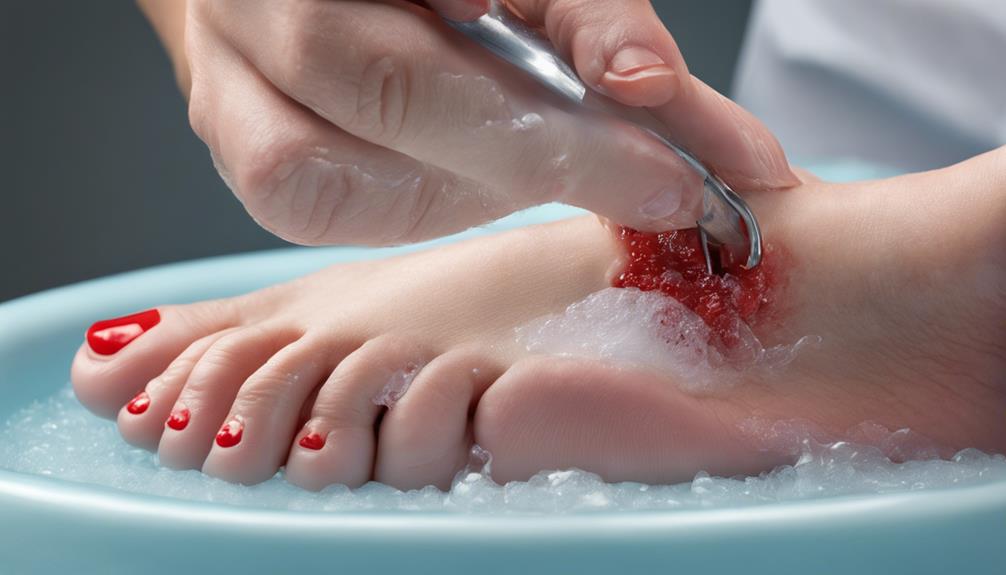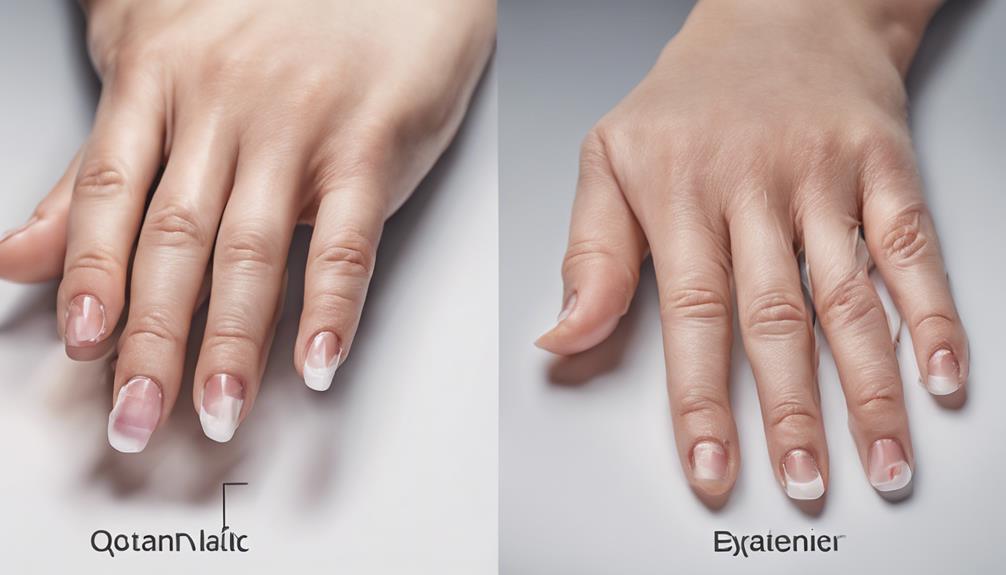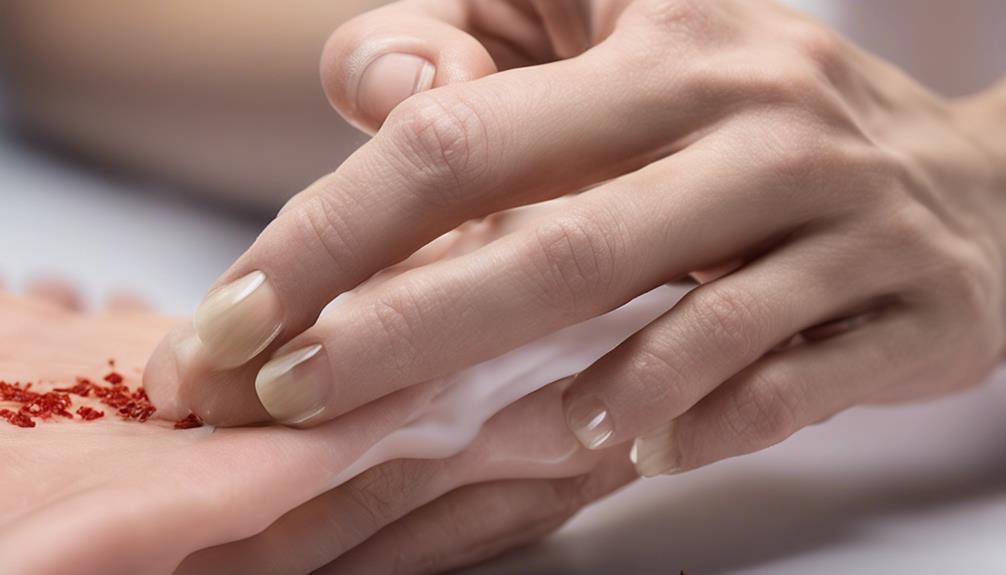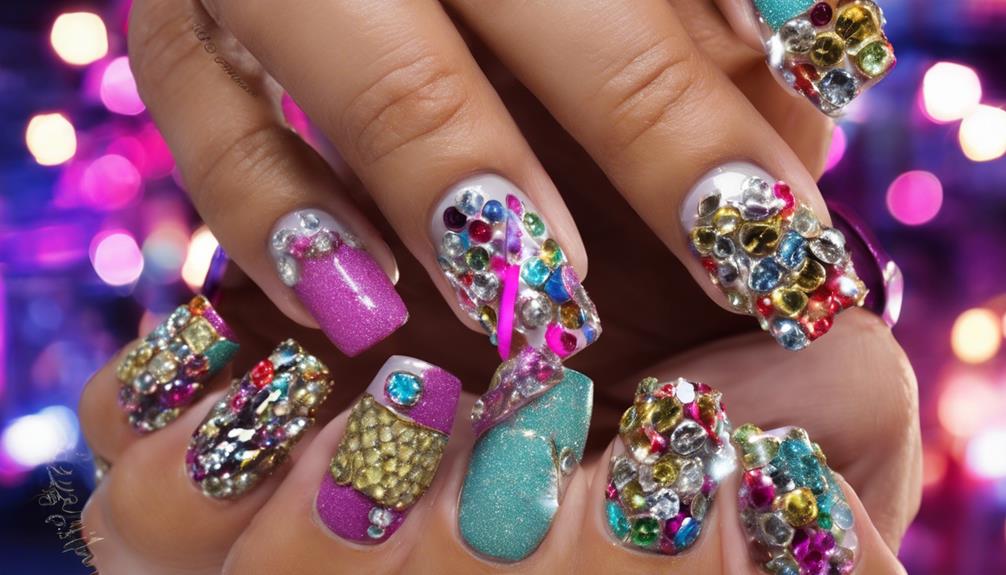When performing a partial nail avulsion procedure, we focus on detailed processes to guarantee successful outcomes. Understanding the technique, preparing adequately, executing the nail removal precisely, providing post-care, and identifying potential complications are essential aspects.
By following each step meticulously, one can promote healing and prevent future issues, leading to a smoother recovery process.
Key Takeaways
- Clear the nail edge and surrounding tissue for precise avulsion.
- Use local anesthesia to ensure a painless experience during the procedure.
- Thoroughly inspect the nail bed for any remaining spicules.
- Apply phenol post-avulsion to prevent regrowth of the nail.
- Follow post-treatment care instructions for optimal healing and recovery.
Understanding Partial Nail Avulsion
When considering partial nail avulsion, it's important to understand the underlying reasons for this surgical intervention. Partial nail avulsion, also known as a lateral nail avulsion, is a procedure commonly used to address ingrown toenails. This technique involves the removal of a portion of the nail, specifically targeting the edge that has penetrated the surrounding soft tissues, causing pain and inflammation.
By excising the problematic section of the nail, the goal of the partial nail avulsion procedure is to alleviate discomfort and prevent the recurrence of ingrown nails. The importance of this procedure is vital to make sure that the nail is trimmed adequately without damaging the nail bed. Additionally, in some cases, a chemical may be applied to the nail bed to prevent regrowth of the removed section.
Understanding the intricacies of the partial nail avulsion procedure is fundamental in providing effective treatment for individuals suffering from ingrown toenails.
Preparing for the Procedure

Before the Partial Nail Avulsion procedure, the affected toe must be adequately numbed with local anesthesia to guarantee a pain-free experience. This ensures a smooth process and comfort for the patient.
Here are some essential steps to prepare for the procedure:
- Clearing the Nail Edge: Carefully removing the ingrown nail edge and any surrounding tissue is vital for a successful outcome.
- Understanding the Nail Bed: Proper knowledge of the nail bed and lateral nail fold helps in precise nail avulsion and matricectomy.
- Local Anesthetic Application: Skillful administration of local anesthetic guarantees the numbness of the area, allowing for a painless procedure.
- Using the Nail Elevator: The nail elevator tool assists in separating the nail from the underlying tissue, aiding in its removal.
- Phenol Application: Applying phenol to the germinal nail matrix post-avulsion prevents regrowth by causing a chemical matricectomy.
These steps, along with techniques like digital blocks and monitoring for granulation tissue, are integral parts of preparing for a successful Partial Nail Avulsion procedure.
Executing the Nail Avulsion Treatment
In executing the Nail Avulsion Treatment, our primary focus is on carefully removing the entire nail plate to effectively address ingrown toenails. This procedure involves gently lifting the nail edge and separating it from the nail bed to guarantee complete extraction.
By performing partial nail avulsion under local anesthesia in a clinical setting, we aim to alleviate discomfort and prevent complications such as infection. Throughout the process, special attention is given to inspecting the nail bed for any remaining nail spicules or irregularities that could hinder proper nail growth post-treatment.
Our approach prioritizes precision and thoroughness to promote excellent healing and nail regrowth. By adhering to these meticulous steps, we aim to provide patients with a successful nail avulsion experience that addresses their ingrown toenail concerns effectively.
Post-Treatment Care Instructions

Upon completing the partial nail avulsion treatment, proper post-treatment care instructions are essential for ideal healing and recovery. Following the surgical techniques used during the procedure, it's important to focus on postoperative care to guarantee successful outcomes. Care for the nail bed and surrounding soft tissue is crucial in promoting the growth of a healthy nail and preventing ingrowing nails.
Here are key post-treatment care instructions:
- Elevate the affected foot to reduce swelling and promote healing.
- Keep the bandage on for the first 24-48 hours to protect the wound site.
- Wash around the wound gently with clean water twice a day after 48 hours.
- Apply petroleum jelly and a nonstick bandage to cover the wound.
- Avoid swimming, self-removal of stitches, and misuse of pain medications for proper recovery.
Potential Complications and Recovery Time

After undergoing partial nail avulsion, patients should be aware of potential complications that may arise and the expected recovery time for best healing. Complications such as infection, bleeding, or incomplete removal of the nail matrix can occur post-surgery. Proper wound care is vital to prevent infection and guarantee ideal healing of the nail bed.
Recovery time following partial nail avulsion typically ranges from 2-4 weeks for complete regeneration of the nail plate and lateral nail bed. In cases of infection, early intervention is necessary to prevent further complications and delays in the healing process. Adequate monitoring of the proximal nail fold and regular follow-up appointments are essential to track progress, address any concerns, and ensure successful outcomes post-matricectomy.
Frequently Asked Questions
How Do You Treat a Partial Nail Avulsion?
We treat a partial nail avulsion by surgically removing a portion of the nail to alleviate pain and prevent infection. Local anesthesia is applied, the nail edge is trimmed, and Phenol is used to stop regrowth.
What Is the Procedure for Nail Avulsion?
We remove the nail plate completely to address ingrown toenails causing pain and infection. Nail avulsion, often complemented by matrixectomy, provides relief and prevents future issues. Proper post-op care is vital for success.
What to Do After Nail Avulsion Surgery?
Following nail avulsion surgery, we must guarantee the toe stays elevated to reduce swelling, adhere to wound care instructions for cleanliness, and avoid wetting the site for 48 hours. Applying petroleum jelly and a bandage aids healing. Reach out to a provider if complications arise.
What Is the First Aid for Nail Avulsion?
First aid for nail avulsion involves cleaning the area with mild soap, applying antiseptic, and covering with a sterile dressing. Elevate to reduce swelling. Seek medical help for severe pain, excessive bleeding, signs of infection, or if reattachment isn't possible.
Can the Treatment for a Ripped Off Acrylic Nail be Applied to a Partial Nail Avulsion?
Yes, the same acrylic nail treatment option for a ripped off nail can be used for partial nail avulsion. It can help protect the exposed nailbed and promote healthy regrowth. Make sure to keep the area clean and dry to avoid infection.
Conclusion
To summarize, partial nail avulsion is a procedure that can effectively treat ingrown toenails. Remember, 'an ounce of prevention is worth a pound of cure.'
By following the step-by-step guide outlined above, you can guarantee a successful treatment outcome. Always consult with a healthcare professional for proper diagnosis and treatment recommendations.
Take care of your feet, they carry you through life!









